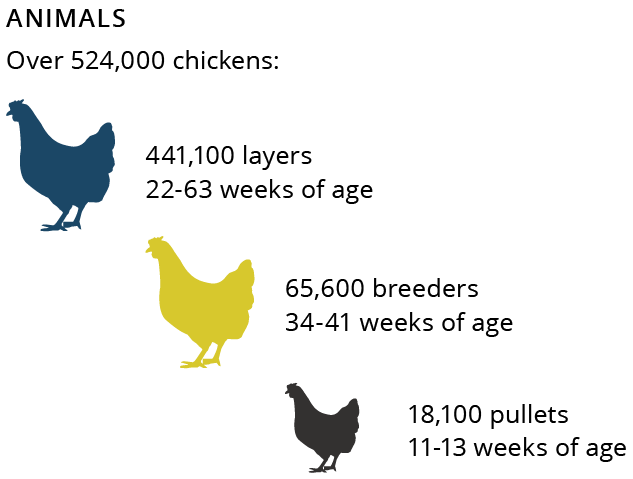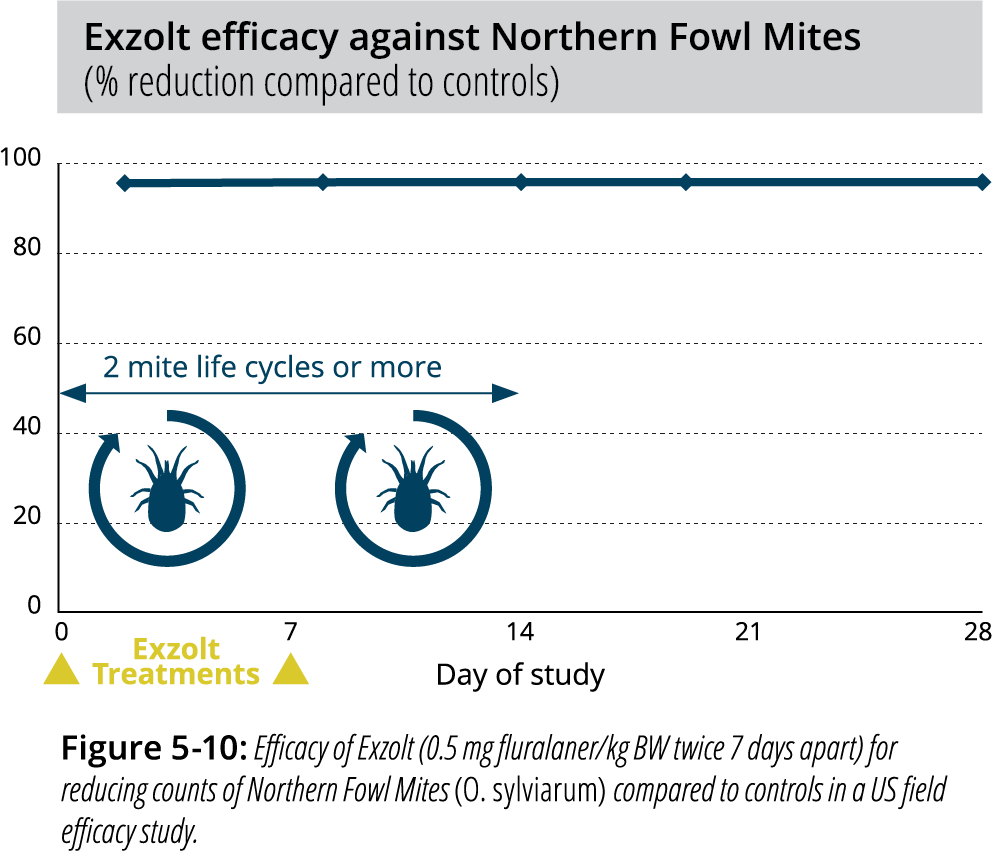Field Trials
An extensive, multi-site field study was conducted in Germany, France, and Spain to evaluate the efficacy of Exzolt (0.5 mg fluralaner/kg BW in drinking water twice at a 7-day interval) for treating natural infestations of Poultry Red Mites (D. gallinae) at a variety of commercial poultry farms.38 The study was conducted at 9 sites involving 5 layer farms, 2 breeder farms, and 2 replacement chicken (pullet) farms, using a protocol similar to previous dose-confirmation studies. The onset of efficacy was very fast, with an overall average mite reduction of 46.6% observed after the first night following the day of initial treatment. Efficacy was more than 97% by day 6 and persisted at that level for a lengthy period of time depending on the farm (100% efficacy at day 14 after the second Exzolt dose in 7/9 farms). A similar degree of fast and high onset of mite control efficacy was observed in all production types (layers, breeders, pullets) and housing systems.
A US field efficacy study was conducted to evaluate the efficacy of Exzolt for treating natural infestations of Northern Fowl Mites in layer chickens derived from a commercial poultry farm in California. The chickens in the study were administered a 0.5 mg fluralaner/kg BW dosage given twice, 7 days apart via drinking water. This study demonstrated that Exzolt provided high (100%) efficacy against Northern Fowl Mite. Treated birds also showed excellent tolerance of Exzolt, with not treatment-related adverse effects observed. The Exzolt dose regimen met and exceeded the target efficacy duration spanning 2 development cycles for Northern Fowl Mites.
To read Northern Fowl Mite study details, click here.

Poultry Red Mite Study
Study Design
- Field efficacy study at 9 sites, controlled and partially blinded. Each site was a qualifying commercial chicken farm (5 in Germany, 3 in France, 1 in Spain) with 2 comparable houses naturally infested with poultry red mites (no recent acaricide treatment). Sites were enrolled between mid May and late July, at the peak of mite season.
- The 2 houses at each of the 9 sites (550-100,000 birds/house) were as similar as possible with regard to size, breed and age of chickens, feed/ water distribution systems, housing system, climate control, and cleaning system (Table 5-2).
- Mite infestation levels of each house were assessed using mite traps. Field isolates of study mites were confirmed to be susceptible to fluralaner using a contact in vitro test (LC90 < 15.63 ppm for 7/9 isolates, and 15.63-31.25 ppm for the other 2 isolates).
- On day 0 at each farm, birds in 1 house were treated with Exzolt (0.5 mg/kg BW/day twice 7 days apart) and the remaining house was left untreated (controls). Houses with the highest mite infestations were usually selected for Exzolt treatment, for animal welfare reasons.
- Additional mite traps were placed at the same locations on day -1 (baseline infestation level) and at multiple time-points thereafter. Traps were removed after 24 hours for mite differentiation and counting.
- Data were also collected regarding the number of dead chickens and laid eggs, and 2 flocks were observed for adverse events. Rates of incubation, fertility, and hatchability were recorded for the 2 breeder farms.
- Personnel involved in the assessment of efficacy and safety criteria were blinded to treatment group assignments.
- The control house at 3 sites (L1, L3, L5) had to be treated for mites during the study due to an unacceptable mite burden (animal welfare). After treatment at site L3, mite counts for efficacy assessment were still available and > 95% through the end of the production cycle at day 238.

Efficiency Criteria
Efficacy assessment was based on the percentage reduction of mites (larvae, nymphs, adults) in the treated house at each post-treatment time point compared to the control house. Production parameters were descriptively analyzed.
RESULTS
The efficacy of Exzolt (against all mite stages) compared to controls is summarized in Figure 5-5. The onset of efficacy was very fast, with an overall average mite reduction of 46.6% observed after the first night following the day of initial treatment (day 0; trap placed and mites collected for 24 hours). Efficacy was already 97.6% on day 3, achieved >97% by day 6, and persisted at that level for a lengthy period of time depending on the farm (100% efficacy at day 14 after the second Exzolt dose in 7/9 farms). A similar degree of fast and high onset of mite control efficacy was observed in all production types (layers, breeders, pullets) and housing systems.
The duration of mite population control following the 2-dose Exzolt regimen was assessed at the house level using a threshold of 90% reduction vs non-medicated controls (Figure 5-6). The duration of mite control was long and variable (2-8 months) and did not depend on the production type or the drinking water system, but was impacted by the duration of the remaining time until the end of the chicken production cycle and on the level of house separation of the compared groups. At 6 sites (L3, L4, B1, B2, P1, P2), no decrease of efficacy was observed until the end of the study (6 to 34 weeks; the 6-week efficacy of the pullet sites reflected the short remaining production cycle and shipment/ removal of the birds). Three sites (L1, L2, L5) experienced a regrowth of the mite population in the treated group after 8 to 18 weeks.
Regarding house separation, the presence of 2 rooms close to each other under 1 roof, separated by a wall but connected by an incompletely hermetic door, allowed faster mite regrowth in the treated house (in about 2 months) at sites L1 and L2 than that observed at farms with appropriately separated houses or rooms. Under real field conditions, the 2 houses would be treated at the same time. In 4 of the 5 layer and breeder farms with an appropriate separation between the study groups (sites L3, L4, B1, B2), the mite population was controlled until the end of the production cycle (16-34 weeks).
Mortality was low at most of the farms and comparable between the study groups before and after treatment. However, the acaricidal efficacy of Exzolt and resulting relief from mite infestation positively impacted the laying rate at 6 of the 7 layer or breeder farms, with a relative increase ranging from 0.9% to 12.6% (Figure 5-7). The sole site with reduced post-treatment lay rate (B1) had a known history of reduced performance in the house selected for treatment relative to the house used as a control. In regard to breeder performance, increased fertility and hatchability rates (2.8% and 1.7%, respectively) were observed at the B2 site, but no improvements were detected at the other B1 breeder farm (site houses not fully comparable for these parameters).
No adverse events related to the use of Exzolt were reported during the study.
CONCLUSION
The field study confirmed the high efficacy and excellent safety of Exzolt when administered in the drinking water (0.5 mg fluralaner/kg BW twice 7 days apart). Under commercial production conditions at 9 diverse layer, breeder, or pullet farms, Exzolt provided fast and persistent reductions in mite counts and positively impacted production parameters (rates of lay, fertility, hatchability). The 2-dose Exzolt regimen successfully controlled natural mite infestations for extended periods, far exceeding the time of actual drug administration (e.g., up to 34 weeks, or nearly 8 months, at 1 layer farm).




The farms covered:
- Relevant chicken production types (layers, breeders, pullets).
- Various housing systems (barn, barn with free-range, enriched cages).
- Various drinking water systems (dosing pump, medication tank, gravity tank).
- Different drinking water compositions.
- Different climatic conditions.
Northern Fowl Mite Study

Study Design
- A controlled, single-site field efficacy study. Commercial layer chickens were obtained as uninfested birds and following a brief acclimation period became naturally infested with Northern Fowl Mite (O. sylviarum).
- 800 healthy birds with established mite infestation were randomly placed into 400 cages (2/cage) on day -6. Cages were then randomly assigned to either of 2 treatment groups (400 cages/group).
- On day 0, birds in 1 group were treated with Exzolt (0.5 mg/kg BW/day twice 7 days apart) using a dosing pump system while the other group remained untreated (controls). Exzolt dosage was based on cage bird weights determined on day -1 and water consumption measured on days -4 and -3.
- Mite vent counts were performed on days -5, 2, 8, 14, 19, and 28. Adequacy of infestation criteria set in the protocol specified that at least 1 bird from 60 of 80 sampled control cages had a mite count ≥ 25 mites per individual bird. The criteria were met at each counting day.
Efficiency Criteria
Efficacy assessment was based on the percent reduction of mites on treated birds compared to untreated controls.
RESULTS
The efficacy of Exzolt compared to controls is summarized in Figure 5-10. Exzolt provided early onset of action as mite vent counts were significantly reduced 99.5% beginning at day 2. Mite count reductions of 100% were achieved on every subsequent sample day, even at 4 weeks after initiation of treatment. No adverse events related to the use of Exzolt were observed.
CONCLUSION
This US field efficacy study demonstrated that Exzolt provided high (100%) efficacy against Northern Fowl Mite (O. sylviarum) infestations of commercial chickens when administered at 0.5 mg fluralaner/kg BW given twice 7 days apart via drinking water. Treated birds also showed excellent tolerance of Exzolt, with no treatment-related adverse effects observed. The Exzolt dose regimen successfully met (and far exceeded) the target efficacy duration spanning 2 development cycles for Northern Fowl Mites.

1 Data on file. MSD Animal Health.
Technical Manual
The development and approval of Exzolt (fluralaner) solution for treatment via drinking water now offers an unparalleled approach for management of poultry red mites in chickens. The Exzolt Technical Manual provides useful and comprehensive information about this cost-effective and revolutionary product.


